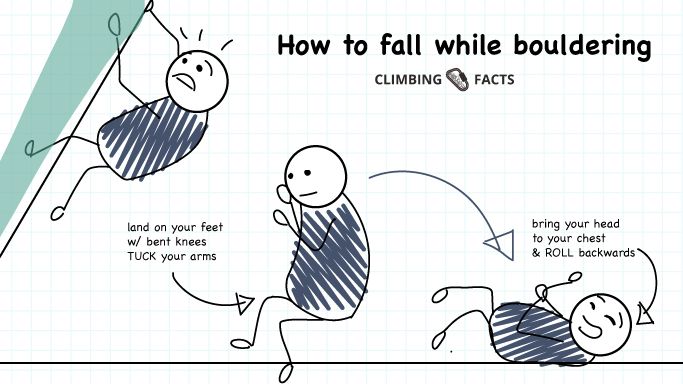Introduction to bouldering
Introduction to bouldering
What is Bouldering?
Bouldering is a form of rock climbing that focuses on shorter climbing routes close to the ground. The finish hold is usually between four to five metres off the ground
Because of its close proximity to ground, this type of climbing is generally done without harnesses or anchoring equipment. To some people, the lack of supporting equipment makes it scarier than other types of climbing such as lead and top-roping.
But the mats are pretty good at catching you (if you fall correctly).

Falling.
That brings me to my next point: falling is a part of it.
It's scary and takes a while to get used to. I've been doing it for 2 years now and I'm still dead-scared of falling and that's okay. In my physio's wise words: "Your body is good at keeping you alive - that's why".
Here's a guide on how to fall safely:

Image taken from climbingfacts.com
However, if you watch people who climb really hard problems, they rarely fall like that 😒. That's because on harder climbs, you often end up in much weirder positions that make it difficult to fall like the above guide. For example:

Fangirling moment 💕 — the image above is of Annie Sanders, one of my favourite female climbers at the moment.
So the better general rule is: if you can't safely fall from a position, don't get into it.
A bonus: my favourite fall from the GOAT Janja Ganbret this climbing season: Youtube Link. I wish I was the brusher..
Some climbing lingo.
-
Beta: Information or sequence on how to complete a climb
-
Flash: Finishing a climb on your first attempt (after seeing or hearing some beta)
-
Send: Successfully completing a climb from start to finish
-
Project: A climb you’re working on over multiple sessions
-
Dyno: A dynamic, jumping move between holds
-
Pump: The burning fatigue in your forearms after climbing for a while
Grading.
There isn't a standard grading method between gyms and it is often location-dependent (a tad annoying). Just ask a friendly local climber - they are happy to help.
Why is it fun?
Obviously, it is very subjective why certain things are fun but if I have to pick one, it's probably the non-repetitive nature of the sport.
Most bouldering gyms do a reset each week so you will get a fresh set of problems to solve regularly.
Don't get me wrong though, it can be very repetitive if you want it to be. Some people like to pick a project and work on it for weeks until they get it. However, if you’re the type who enjoys challenging yourself with something new each week, it’s a blast.
Is it safe?
For indoor bouldering, it is quite safe as long as you follow the rules (e.g. falling correctly).
It can be dangerous if you choose to put yourself in riskier positions.
What not to do in your first session.
There’s hardly anything you can do “wrong” in this sport — everyone’s usually pretty nice and understanding.
Except when you hog the wall and climb without looking.
If you’re not climbing, try to stay out of the falling zone.
Before starting a climb, make sure no one else is going to cross paths with you on the wall. Usually, an arm-span distance is a good estimate. This is mainly because if you both fall at the same time, it’s much harder to land safely.
Conclusion.
That's it for a quick introduction to Bouldering.
It's okay to be bad and still have fun.
This is the advice I gave to myself when I started - and still now. I'm not very good at climbing, but I had fun everytime I go.
- ← Previous
Dataclass in Python - Next →
My k8s dictionary